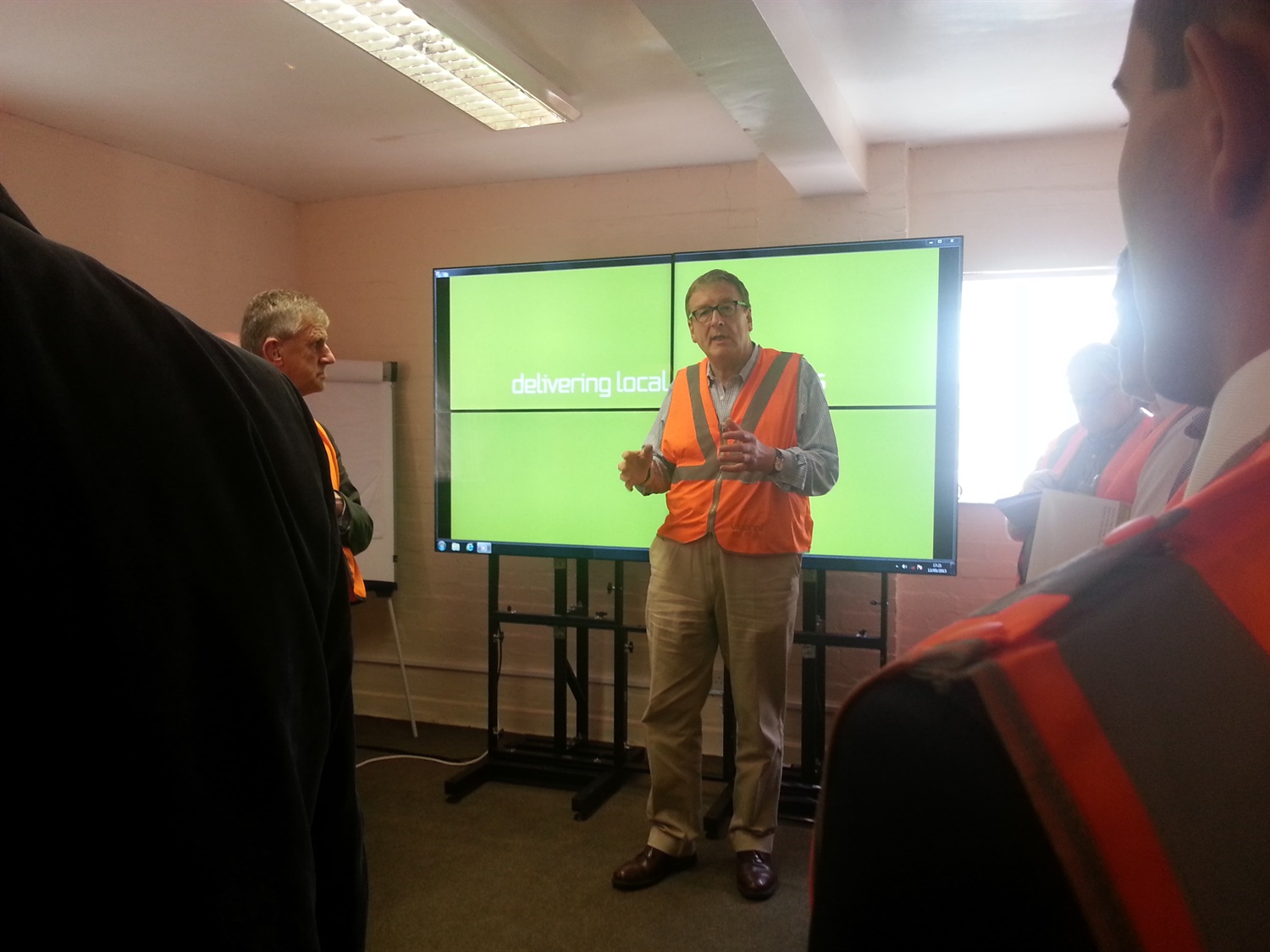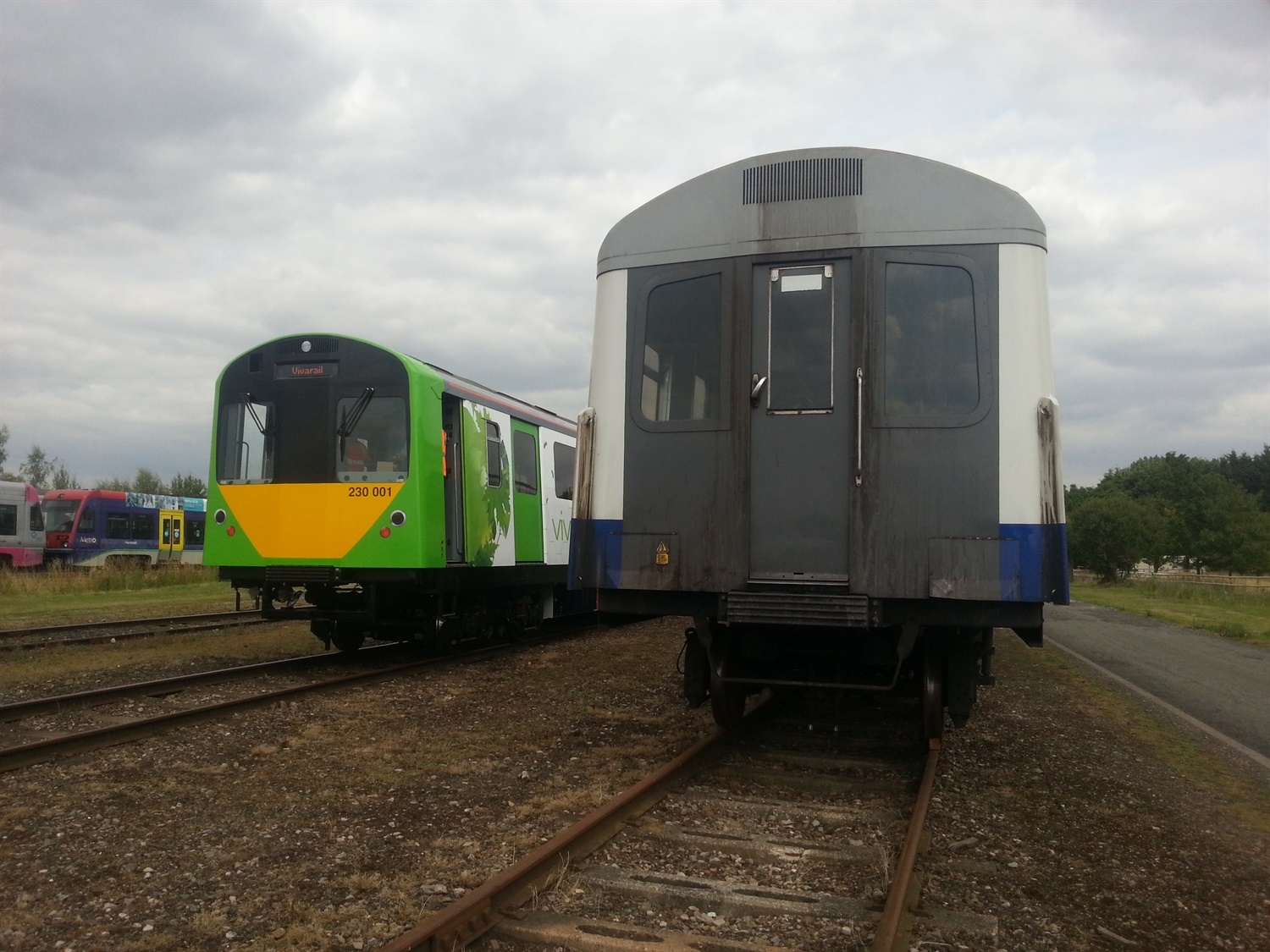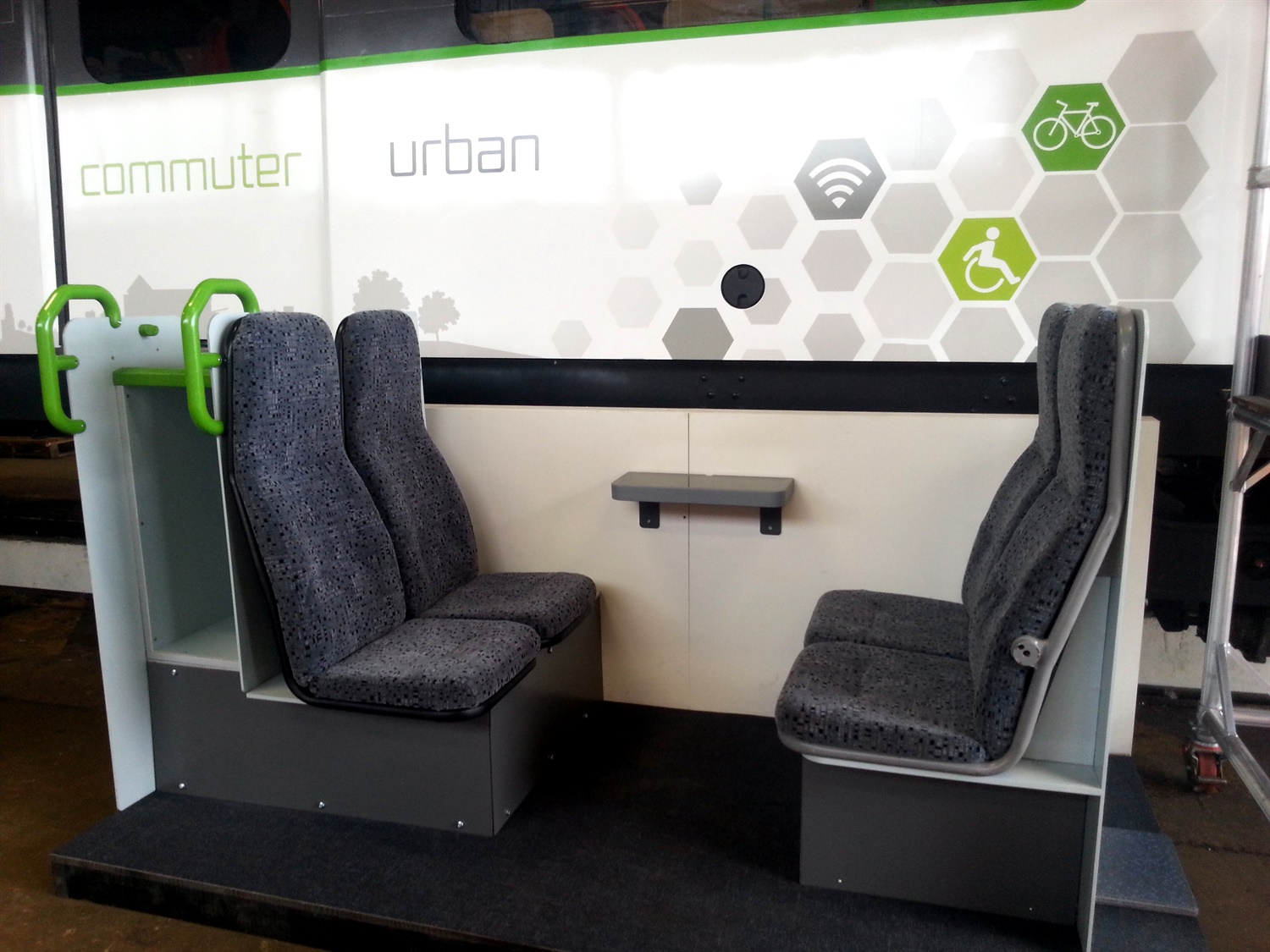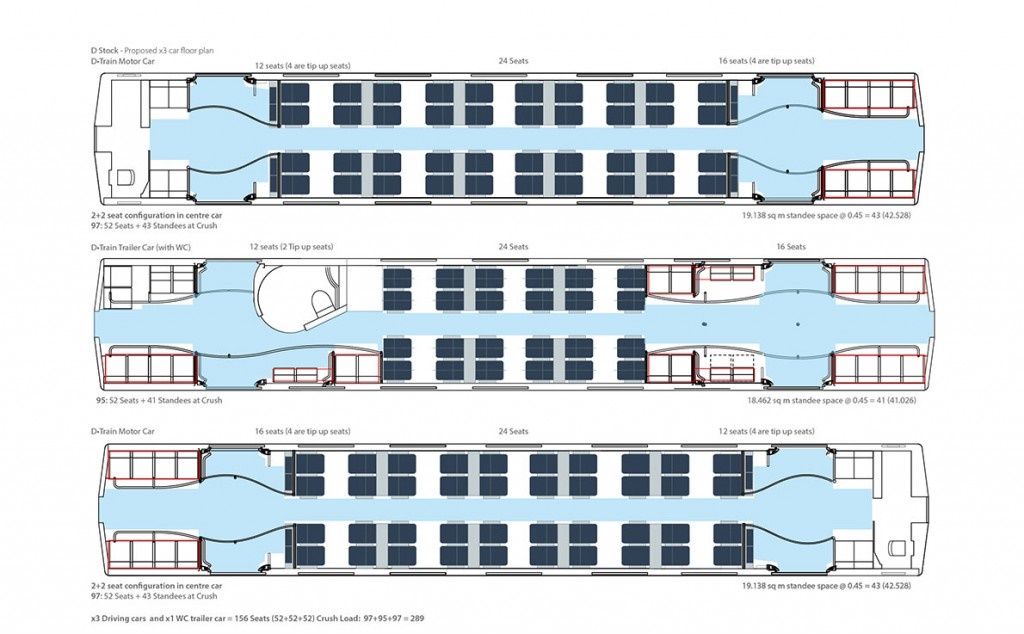01.08.15
Comfort, cost and fuel-saving – the case for the D-Train
Source: RTM Aug/Sep 15
RTM’s Luana Salles visited Vivarail to see its converted D-Trains and came away impressed.
Seeing a converted DMU D-Train parked side-by-side to the original D78 District Line car proved what Vivarail has been telling us ever since it established itself three years ago: they are nothing alike.
As we previously reported in the April/May 2015 edition, the D-Train Class 230 prototype – slathered in green paint in an attempt to convince visitors at the Quinton rail facility at Long Marston that it is “the UK’s greenest train” – has kept only the original bodyshells, bogies and motors from its original form as LU electric stock.
Inspired by increasingly lighter and more efficient Japanese trains, Vivarail’s upcycled D-Train seeks to accommodate the different demands of local rail services.
As good as new
With stop-start technology – meaning the engine shuts down when it isn’t needed – and fast acceleration due to traction systems based on Insulated Gate Bi-polar Transistor (IGBT) technology, the train is “thoroughly modern”. It boasts a high power-to-weight ratio and purpose-designed control characteristics to give it a high rate of acceleration, ideal for commuter routes with frequent stops.
“We specifically designed it to make it really comfortable for passengers, to make it use much less fuel than existing trains, to make it cost much less to maintain than existing trains, and, of course, because of the fact we’re reusing some major components, the capital cost will be lower,” Adrian Shooter, Vivarail’s CEO, told us.
 Adrian Shooter, Vivarail's CEO, speaking at the event.
Adrian Shooter, Vivarail's CEO, speaking at the event.
Shooter, who has an extensive rail background – starting with his leadership role at his school’s railway society and most recently as chair of Chiltern Railways – said the trains served the District Line well.
“They learnt lots of lessons from slightly less satisfactory trains they had in the past, and incorporated them all into this. You could actually draw a parallel between these coaches and the British Rail Mark 3 coach,” he said.
He added that the bodyshells are made almost entirely from corrosion-free aluminium, apart from a bit of steel where the bogies are attached, to strengthen the structure. Although the shells are almost 30 years old, they have been made “as good as new” after being re-engineered for additional collision protection – proved effective after a successful crash test into a three-tonne tank of water.
And “by a stroke of luck”, as Shooter calls it, LU replaced the bogies after the original ones fell to bits because they were not solid enough. They were too rigid for their tracks and had to be replaced from 2000-03 using Bombardier bogies (Adtranz, then). The new version, similar to those used on Northern Line stock, had a flexible frame designed to give a good passenger ride despite the track quality. These bogies are still available in Bombardier’s sales catalogue.
The existing electric motors in the train are now powered by new underfloor-mounted low-emission diesel engines. Some of the engineers responsible for the conversion were involved in the original design of the trains when they were new.
 A converted D-train unit sitting next to original London Underground stock.
A converted D-train unit sitting next to original London Underground stock.
Bespoke design
Though the three-coach prototype on display at the facility – which we took for a test drive on the 24km track – kept the same basic framework from its LU predecessor, the trains Vivarail are offering span a variety of configurations and designs to suit the needs of operators, including a two-car option. They will also all be fitted with the signalling interface systems needed for operation on Network Rail infrastructure and will have relevant approvals and certifications in place.
In the company’s workshop, a converted carriage showcased the three interior designs Vivarail is offering: heavy commuter, outer commuter and country. The cheapest option retains the same basic layout as it had when serving the District Line. “It is absolutely ideal if you want an affordable train for shifting crowds to football matches, for relatively short journeys. That’s what it’s designed for and that’s what it’s been doing for 30 years very well on the District Line, so why change that? However, all sorts of other uses are possible,” Shooter told us.
The unpowered middle car in the workshop also displayed the other possible layout mock-ups for the purpose-built trains, including a longer continuous seat, built by Transcal, ideal for longer journeys, and a (less popular) long seat with a division between the head and body cushion frame. The tables were designed to be bigger than regular commuter tables, similar to those in Class 180s.
The example coach in the shed also demonstrated Vivarail’s vision for easier suitcase and bicycle storage by adding a storage space between back-facing seats. The storage was topped with a small ‘station’ ideal for laptop and tablet users needing to work. Furthermore, Neil Bates, a director at Creactive Design and Vivarail, told us that barriers between seats were low all throughout the coach to make women feel safer at night-time or on emptier journeys – they have indeed thought of everything. The train, when nearing its December completion date, will also be fitted with a modern 360° lavatory developed and engineered for a sum total of £100,000.
 One of the seat options, built by Transcal, in front of the unpowered prototype.
One of the seat options, built by Transcal, in front of the unpowered prototype.
Finished stock
The prototype we rode in, already nearing completion, is a base model for all future converted stock, featuring the same framework as the District layout – albeit with much more comfortable seats. It felt like an ideal coach for commuter services, with the original three-coach providing 150 spacious seats while reserving 130 spaces of standing room for quick travellers. The train also cut almost imperceptibly through the facility’s greenery with an engine quieter than that of the bus we rode in to get to the facility. The general feeling during the trip, which was capped at a lower speed than the train’s 60km/h capacity, was of utter disbelief at what the Vivarail team managed to do with the once relatively old, vandalised LU fleet. Every councillor and transport representative from all over the country I spoke to during the short trip was satisfied with how far the D-Train had come.
Although Vivarail did not confirm anything at the time, there were talks throughout the day of potential Northern Rail investment, with representatives from the franchise set to visit the facility the following day. Other less substantiated whispers also speculated about First Great Western and Abellio Greater Anglia buyers. Assuming ongoing negotiations go well, Vivarail is hoping to see the trains in passenger service from January.
 Design layout mock-ups for the different D-train units.
Design layout mock-ups for the different D-train units.
Southern Railway’s lead engineer, David Hickson, who was also present at the Warwickshire facility when RTM visited, left the site determined to engage with the East Sussex Rail Alliance campaign group, which think the converted trains could be used to fulfil the need for five more diesel sets, to ease overcrowding on the Brighton-Eastbourne-Hastings-Ashford services along the south coast.
Southern cannot lease or buy new DMUs like the existing Class 171 Turbostars for the East Coastway route because of DfT-imposed budget restrictions, the passenger group says, but it thinks Vivarail could provide a cheaper solution.
Although several parts of the country are counting on electrified lines by 2020, the ‘pause’ on works means most TOCs must fill the gaps of timeworn diesel stock or risk losing a significant number of passengers. Yet because of electrification promises, suitable replacement diesel rolling stock is in short supply, with the national DMU fleet being fully utilised and many existing trains not meeting passengers’ aspirations.
The Vivarail D-Train solution will not be suitable everywhere, but its combination of modern technology and innovative systems to provide a low-cost, low-emission solution to keep all services running smoothly will certainly help fill some gaps.